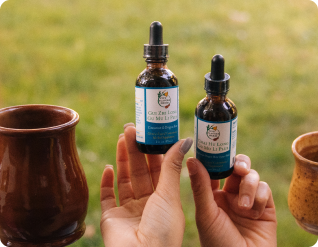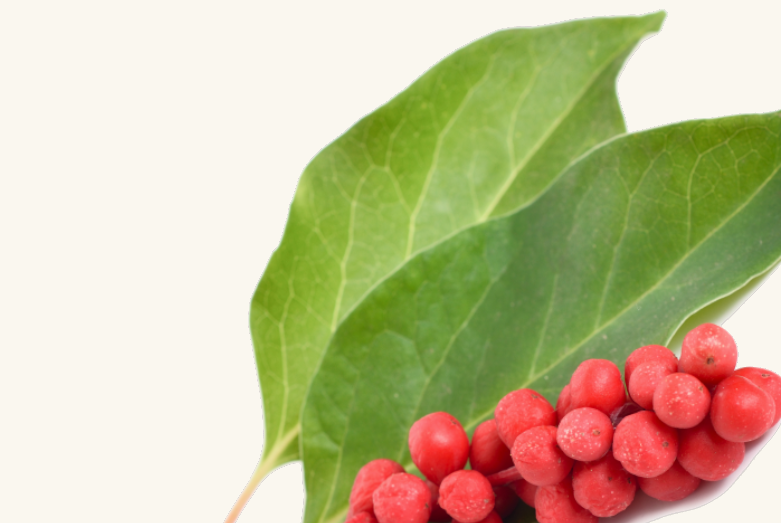
Delivery Matters!
The way you consume or prepare your herbs will vary depending on the type of formula you have, like a tincture, tea, granule, or another type of preparation. Let’s look at each preparation below and explore the best way to enjoy it!
Remember, if you are pregnant, breastfeeding, have a medical condition or take prescription medications, check with your healthcare practitioner before starting any health program.
Tinctures are concentrated liquid extracts that contain alcohol. They offer quick support and are a wonderful option for folks with an active, on-the-go lifestyle. To take a tincture, squeeze 1-2 droppers full directly on or under your tongue. To improve the flavor (they can be potent!), dilute 1-2 droppers full in 1/4 cup of water, tea, or juice and then drink.
The average dose for an adult is 1-5 droppers full (one dropper is equivalent to approximately 1 mL or 30 drops) taken 1-4 times per day. Adjust your dosage based on the recommendations on the bottle or the instructions provided by your practitioner. If you want to avoid the alcohol content of tinctures, then you may also want to ask your practitioner about glycerites (a non-alcoholic herbal extract), teas, or teapills.
Learn more in our blog post, Herbal Tinctures for Natural Health Support.
SHOP TINCTURES
Liquid concentrates are similar to tinctures; the main difference is how they’re prepared at our facility. (With a liquid concentrate, the herbs are decocted in water before the alcohol is added, and they contain almost 50% more herbal material than a tincture, which makes them more potent!)
Like tinctures, liquid concentrates are a fantastic option for quick herbal support, especially for anyone who lives an active lifestyle and needs a formula they can grab on the go.
To take, fill the dropper as full as you can, and then squeeze its contents directly on or under your tongue. You can also dilute 1-2 droppers full in 1/4 cup of water, tea, or juice and then drink.
The average dose for an adult is 1-5 droppers full (one dropper is equivalent to approximately 1 mL or 30 drops) taken 1-4 times daily. Adjust your dosage based on the recommendations on the bottle or the instructions provided by your practitioner.
For practitioners, we offer a wide selection of liquid concentrates through our herbal pharmacy or you can purchase wholesale online.
Shop Liquid Concentrates
Glycerites are similar to tinctures and liquid concentrates, except they contain a base of food-grade vegetable glycerin rather than alcohol. The sweet-tasting, non-alcohol base makes glycerites a wonderful choice for children or anyone sensitive to alcohol. To take glycerites, squeeze 1-2 droppers full directly under or onto your tongue. You can also dilute the glycerite by squeezing 1-2 droppers full into ¼ cup water, tea, or juice. Adjust your dosage based on the recommendations on the bottle or provided by your practitioner.
SHOP GLYCERITES
A granule is an herbal decoction that’s freeze-dried on a starchy medium. It resembles a powder and is a popular way to consume traditional Chinese medicine. The benefits are similar to a traditional decoction but without all the work.
You will want to dissolve your granules in warm water to enjoy their benefits. Use the spoon from your granules container to add 1-2 grams (or as directed) to ½ cup warm water. Stir well to dissolve, then drink 2-3 times daily or as often as your practitioner recommends.
*Granules are only available through our herbal pharmacy as a prescription from a healthcare practitioner.

Teapills are small, black pills made from dehydrated tea (hence the name!). Unlike conventional over-the-counter pills, teapills are made from natural botanical ingredients and are often recommended by holistic practitioners. The pill format makes them easy to ingest, and you can pack them in your purse or bag to take with you throughout the day.
To take your teapills, follow the same process as you would consume any other pill. Teapills are very small, so you can easily take many at once. Simply put the pills in your mouth, drink water, and gulp them down. The typical adult dosage for teapills is eight pills taken three times daily. However, it’s always best to follow the instructions provided by your practitioner or printed on your bottle.
Shop TCM & Tea Pills
Loose-leaf herbs are easily prepared at home as a nourishing tea. If you are working with the aerial parts of the plant, like the leaf, stem, or flower, then you will want to prepare an infusion.
How to make a hot infusion
- Craft an infusion when making tea from aerial plant parts, like leaves and flowers. Add 1 tablespoon of herbs to a tea strainer placed inside a mug, then fill with hot water.
- Cover the mug with a small plate to trap the beneficial volatile oils otherwise released as steam.
- Let the tea steep for approximately 5 minutes before uncovering and removing the strainer.
- Serve hot. Sweeten with raw honey if desired.
Pro tip: For bigger batches of tea, use a teapot or French press and add 8 ounces of hot water for each tablespoon of loose leaf tea.
Shop Loose Leaf Tea
Loose-leaf herbs are easily prepared at home as a nourishing tea. If you are working with the aerial parts of the plant, like the leaf, stem, or flower, then you will want to prepare an infusion.
How to make a cold infusion
Some herbs, like marshmallow root, are best extracted in cold water. Follow these instructions if the label on your herbs (or the instructions from your practitioner) mentions a “cold infusion.”
- Combine 2 tablespoons of plant material with 16 ounces of water in a French press, teapot, or glass jar.
- Place the container on the counter and let steep for 4-8 hours.
- Strain the plant material from the tea, and enjoy!

Loose-leaf herbs are easily prepared at home as a nourishing tea. If you’re working with denser parts of the plant, like the root, bark, or berries, then you will want to prepare a decoction.
How to make a decoction
Decoctions are the preparation of choice when making tea from the plant’s roots, bark, dried fruit, or seed.
- In a glass or ceramic pot suitable for the stovetop, add your herbs. For Western herbs, the standard ratio is 1 tablespoon to 1 cup water. For Chinese herbs, a typical dose pack is added to 8 cups of water and decocted until there are 6 cups remaining. Remember to follow any specific instructions on your prescription package.
- Simmer, covered, for 20-30 minutes.
- Use a fine mesh strainer to separate the tea from the plant material.
- Serve warm.

Essential oils are concentrated plant extracts made by distilling aromatic plant parts. These compounds activate the olfactory receptors in our noses, which send signals directly to the brain, which is why they’ve gained much popularity over the years for both physical and emotional health support. It’s important to always source your essential oils from sustainable suppliers because it takes an enormous volume of plant material to make a single, precious drop of essential oil.
There are several ways to use essential oils for maximum benefits. Remember, essential oils are not for internal use, and should rarely be applied directly to the skin due to the risk of irritation.
- Diffusers: Essential oil diffusers come in many varieties, each offering an efficient way to fill your space with beneficial plant essences. For best results, consult the directions for your specific diffuser model, then start experimenting with your favorite single oils or combinations.
- Topicals: While essential oils can certainly be applied to the skin as either therapeutic fragrance or skin support, they must be diluted to a safe level to avoid skin irritation. In a 10 mL roller bottle, combine 5 to 10 drops of essential oil with a carrier oil like jojoba, almond, or sesame oil, secure the lid, and shake to mix. Then, apply the diluted oil under the nostrils, across the chest, or on pulse points, like your wrist or behind your ear.
- Steam Inhalation: For sinus and lung support, add 2-5 drops of essential oil to a bowl of just-boiled water. Drape a towel over your head, then lean in to inhale the aromatic steam. Be careful not to inhale the warm steam too quickly as it can burn your sensitive sinus tissues.
- Direct Inhalation: For on-the-go relief, you can inhale essential oils directly from the bottle. Simply open the bottle, bring it a few inches from your nose, close your eyes, and breathe in.
Learn more in our blog posts Aromatherapy & Essential Oils in Chinese Medicine and 10 Essential Oils for Sinus Health.

A flower essence is a subtle energetic medicine that tends to our essential emotional, mental, and spiritual well-being. By tuning in to the flowers around us, we can gain more insight into ourselves and our natural environment. A flower essence is generally a solar and water extraction of the vital life force of a plant. The water captures the beneficial energetic properties of the flower, which we can use to gain self-insight and rework patterns that may not be serving us.
You can use essences in baths, steams, sprays, topically on chakra points, or sprinkled on a pillow at night. They are often taken orally, either straight from the dropper, or added to tea or water. A standard dosage is 3-4 drops taken 3-4 times per day, though you can work with them as little or as often as you like.
You can keep a journal to help notice any insights you feel upon taking the essence, immediately and over time. When you take a few drops, close your eyes, feel the magic they offer, and let the flowers connect you to the earth around you.
Learn more in our blog post, How to Make & Use Flower Essences.
Shop Flower Essences


